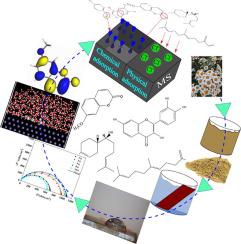Journal of Molecular Liquids ( IF 6 ) Pub Date : 2021-09-16 , DOI: 10.1016/j.molliq.2021.117570 M.H. Shahini 1 , Motahhare Keramatinia 2 , Mohammad Ramezanzadeh 2 , Bahram Ramezanzadeh 2 , Ghasem Bahlakeh 3

|
This investigation parallels the others hoping to address the environmental predicaments. Dealing with the corrosion progression of steel, being in battle with a harsh condition (HCl), using the novel Chamomile flower extract (CFe) could embody the advantageous lies in the green molecules of plants. The morphological influences of this plant extract were studied by exploiting the power of FE-SEM, EDAX, AFM, and contact angle examinations. Results were demonstrative of the surface smoothness increment after CFe inclusion into the medium; smoothing the surface as well as lowering the iron dissolution. Besides, the surface was characterized via GIXRD as well as Raman spectroscopy. In addition, the adsorption of the inhibitor was examined through UV-Vis analysis. The existence of functional groups like C=O and C=C, the reduction of iron dissolution, and the graphene-like compounds' existence confirmation on the metal surface, all subsequent to CFe loading, were the outcome of these assessments. The EIS and potentiodynamic polarization (PP) tests were performed. The outcome showed that the CFe could inhibit the corrosion proliferation substantially especially when the steel was exposed to 600 ppm solution for 8 h; a 98% inhibition efficiency was obtained. The calculations exhibited the CFe mixed inhibitive characteristic and Langmuir was the adsorption isotherm strategy of the studied inhibitor. Finally, the study was further expanded into the theoretical point of view in which the adsorption of inhibitor molecules on the surface was confirmed; in agreement with the experimental outcome.
中文翻译:

洋甘菊花提取物作为 HCl 溶液中低碳钢的腐蚀抑制剂的原子尺度/DFT 理论模拟和电化学评估的组合
这项调查与其他希望解决环境困境的调查相似。使用新型洋甘菊处理钢的腐蚀进程,与恶劣条件 (HCl) 作斗争花提取物(CFe)可以体现植物绿色分子的优势。通过利用 FE-SEM、EDAX、AFM 和接触角检查的能力研究了这种植物提取物的形态影响。结果证明了在介质中加入 CFe 后表面光滑度增加;平滑表面以及降低铁溶解。此外,通过GIXRD以及拉曼光谱对表面进行表征。此外,通过UV-Vis分析检查了抑制剂的吸附。C=O 和 C=C 等官能团的存在、铁溶解的减少以及金属表面上石墨烯类化合物的存在确认,所有这些都是在 CFe 加载之后的结果。进行了 EIS 和动电位极化 (PP) 测试。结果表明,CFe 可以显着抑制腐蚀扩散,尤其是当钢暴露于 600 ppm 溶液 8 小时时;获得了 98% 的抑制效率。计算结果显示了 CFe 混合抑制特性,Langmuir 是所研究抑制剂的吸附等温线策略。最后,将研究进一步扩展到理论观点,证实了抑制剂分子在表面的吸附;与实验结果一致。计算结果显示了 CFe 混合抑制特性,Langmuir 是所研究抑制剂的吸附等温线策略。最后,将研究进一步扩展到理论观点,证实了抑制剂分子在表面的吸附;与实验结果一致。计算结果显示了 CFe 混合抑制特性,Langmuir 是所研究抑制剂的吸附等温线策略。最后,将研究进一步扩展到理论观点,证实了抑制剂分子在表面的吸附;与实验结果一致。



























 京公网安备 11010802027423号
京公网安备 11010802027423号